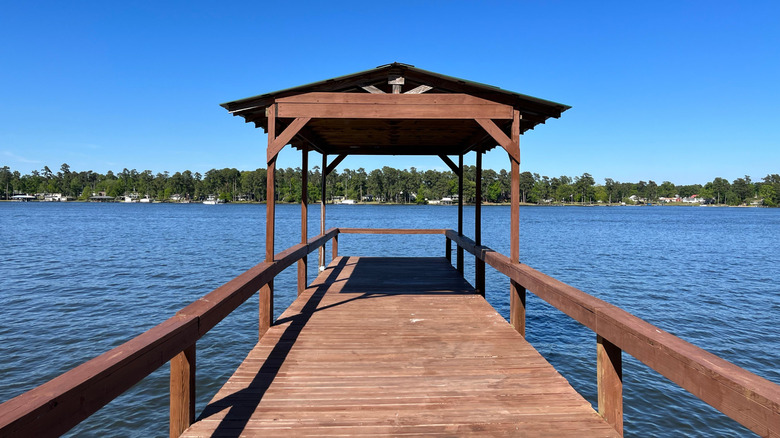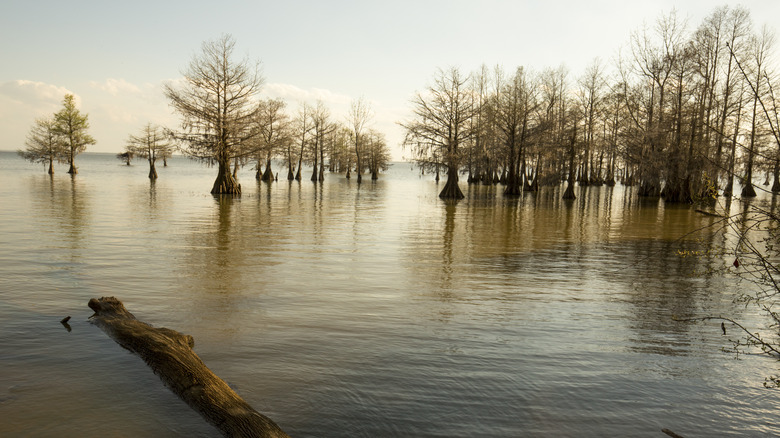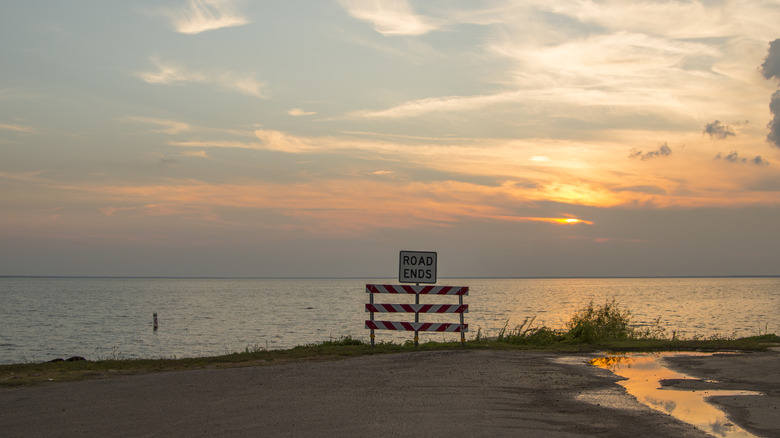
Most travelers know South Carolina for one of its most populous cities, Charleston –– the gorgeous destination that blends a striking European appearance with Southern charm. Or perhaps they're aware of the cute towns and cuisine on South Carolina's soulful coastline in the low country. There's another side to the state's appeal if you head more inland, where cypress trees rise from swampy lakes and dragonflies hum alongside the casts of fishing rods. Lake Moultrie and Lake Marion — jointly known
as the Santee Cooper Lakes — offer some of the best of South Carolina's untamed inland nature, rich with wildlife, recreational opportunities, and a particular reputation for enormous catfish.
Although the Santee Cooper Lakes, with their shadowy swamps and winding floodplains, have an ancient feel, they were actually artificially created as part of a construction project in 1939. This project was sponsored by the Public Works Administration, an agency formed as part of the 1933 New Deal, to both stop flooding from the Santee River Basin and generate electricity from hydroelectric dams. One of those is the Pinopolis Dam and Lock, which, at 138 feet, was the highest single-lift lock of its time and still provides electricity today. The tailwaters of the dam are popular for fishers, since it's where fish migrating upstream are concentrated as they pass from the Cooper River into the lake. Aside from fishing, the lakes' cypress-dotted waters are also popular for hiking, wildlife viewing, and sunset cruising.
Read more: The Best Vacation Destinations Where The US Dollar Goes Furthest
How The Santee Cooper Lakes Transformed From Floodplains To Open Water

Before the two Santee Cooper Lakes were created, the area they now exist on was prone to severe flooding. That, paired with the region's lack of reliable electricity, led to the creation of the Santee and Pinopolis dams, which pooled water into the formations of Lake Marion and Lake Moultrie, respectively. There was a cost to making these lakes, though, because the area wasn't empty — people, mostly Black families, were living there and had to be relocated. According to the International African American Museum, about 900 families were displaced, having to clear the new land they were moved to themselves. One community was the town of Ferguson. You can still see ruins from the now-submerged town, including a lumber kiln and a cemetery, scattered on small islands in the lake.
With the creation of the lakes, there was also a massive ecological shift. Swampland was cleared, trees cut down, and wildlife populations changed with the changing habitat. Waterfowl went down drastically in population when the lakes were initially made, but today, the north shore of Lake Marion is home to the Santee National Wildlife Refuge, designed to conserve the crucial habitat for migratory birds and listed as an Audubon Important Bird Area. Indigo buntings, orioles, and tanagers are some birds you're likely to see in the spring as they migrate. In the fall and winter, many migratory shorebirds arrive from their Northern summer habitats, including Canadian geese, cormorants, and ducks.
Wildlife And Trails Around The Santee Cooper Lakes

You can get the most of the nature and wildlife around the Santee Cooper Lakes by exploring one of the hiking trails that wind around the open waters and swampland. The Caddo Loop Trail is a great option for beginners who want to spot some wildlife. It's about 2 miles in length, weaving through the Santee National Wildlife Refuge. You're bound to see some waterfowl, alligators lounging on the lakeside, or white-tailed deer flitting among the cypress trees. Lake Moultrie is skirted by a portion of the 500-mile Palmetto Trail, which threads through the state's nature and picturesque regions like the friendly Olde English District with its small town charm. The Lake Moultrie Passage of the Palmetto Trail covers nearly 27 miles, meandering among pine forest and beaches with views across the lake.
The lakes are famously top-notch fishing destinations. Lake Marion holds the world record for the largest channel catfish caught, which was 58 pounds. According to Coastal Angler Magazine, the largest of all catfish caught at the lakes was 143 pounds. If you want to try your luck at these gargantuan catfish, the best time to fish for them is in the fall. The lakes are also known for their striped bass — typically saltwater fish, they've remarkably adapted to the lakes' freshwater. Your best bet for catching largemouth bass is in spring, when they migrate to shallow waters. Hot months are harder for fishing, since the fish move to cooler waters.
At the narrow neck of Lake Marion, the Santee Welcome Center provides information about the lakes, resources for reserving an overnight stay, and trail guides. If you're flying in, it's about an hour drive from the Charleston International Airport.
Ready to discover more hidden gems and expert travel tips? Subscribe to our free newsletter for access to the world's best-kept travel secrets.
Read the original article on Islands.













